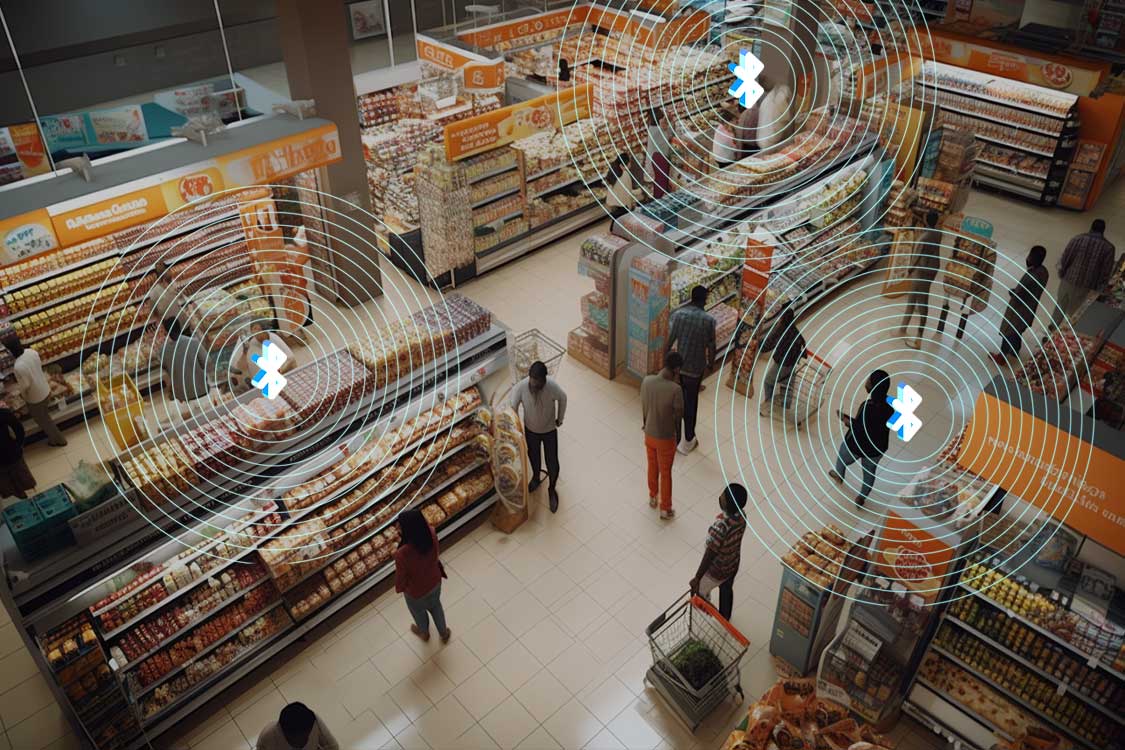Technology Trends

In the realm of indoor navigation systems and location technology, bluetooth navigation systems that use Bluetooth Low Energy (BLE) beacons have garnered popularity. Countless articles on the internet extol the virtues of BLE beacon technology, positioning it as the frontrunner in a rapidly advancing sector.
According to a report published on Globe Newswire, the sales of beacons, which serve as the foundation of Bluetooth indoor positioning systems, are projected to experience a substantial growth rate of 26.8%, culminating in $15.5 billion in revenue by 2025.
However, amidst this popularity, it is crucial to examine whether BLE indoor positioning technology truly lives up to its reputation. Is it the best solution for your location-technology needs?


In this Blog Post We’ll Examine:
- The underlying principles of BLE indoor tracking technology and its role in indoor navigation.
- Pros of BLE positioning systems.
- Cons of BLE beacons.
- Groundbreaking solutions to these challenges presented by pioneering hardware-free location technology advancements.
Bluetooth Positioning and Tracking: Pros, Cons and Innovative Alternatives
Bluetooth localization and tracking stands as one of the pioneering technologies that has established the foundation of the navigation landscape. Individuals now navigate, interact and effortlessly use smart devices powered by BLE technology. While it is tempting to view Bluetooth solely as a means of augmenting the capabilities of wireless technologies and gadgets, it is not without its own set of challenges.
Firstly, ensuring the presence of reliable hardware, chipsets, power sources, and managing challenges such as installation and signal interference are crucial considerations. Notably, a persistent issue with BLE lies in the intricacies of establishing a functional system that operates seamlessly with Bluetooth technology. Particularly indoors, integrating Bluetooth and GPS systems poses notable accuracy challenges, as the interactions between these technologies can critically affect accurate indoor navigation.
The Transition from Outdoor to Indoor Positioning
In recent years, advancements in GPS technology have brought about radical changes in the field of wayfinding. Our navigation habits, whether they involve driving or walking, have experienced a transformative paradigm shift. The catalyst for this change can be traced back to mobile phones, which has paved the way for further developments. Notably, there is a visible shift in focus from outdoor navigation to indoor navigation, leading to the demand for indoor positioning systems that work flawlessly on mobile phones, powered by geospatial sensor data.
Indoor positioning systems (IPS) represent a cutting-edge technology that enables precise localization within enclosed spaces where traditional GPS signals and Bluetooth are limited. These spaces encompass a wide range of environments, including shopping malls, hospitals, mult-event facilities, factories and higher-education facilities. Essentially, anything that individuals, businesses or organizations seek to locate and track within an indoor setting becomes the focal point of spatial intelligence technology today.
Currently in the indoor technology market various localization methods exist, with BLE beacons standing as the most recognized approach. These beacons can be classified into two categories: iBeacon, a proprietary technology pioneered by Apple, and Eddystone, an open-source protocol developed by Google. While they may vary in certain functional aspects, their overarching impact remains largely comparable.
Bluetooth Indoor Navigation: The Basics
Bluetooth indoor navigation comprises a network of transmitters, commonly referred to as beacons, strategically positioned within an interior space. Analogous to lighthouses guiding ships at sea, these beacons emit signals that serve as navigational cues. The signal transmission of a Bluetooth beacon is unidirectional, akin to a concise message proclaiming its presence: “Hey, I’m here!”
Nearby devices, primarily smartphones, receive these beacon transmissions, deciphering a brief packet of information similar to the beacon’s identifier. No device-to-device connection is established; rather, the signal is observed like a beam of light spanning across the sea, where the source of the signal is noted, concluding the interaction. Upon reception, the incoming transmission triggers a predefined event, customizable based on the specific location and purpose.
Shortcomings of Bluetooth-Based Location Technology: The ABCs
Although BLE beacon systems offer extensive possibilities and numerous advantages, it is essential to acknowledge their inherent limitations. Specifically, when addressing scenarios necessitating precise and real-time indoor localization, certain drawbacks become evident. These limitations predominantly revolve around aspects such as accuracy, battery life and cost.
Positioning System Comparisons
A – Accuracy
The signal emitted by a beacon operates on a radio frequency, subject to the same interferences encountered by any radio frequency. Various factors – such as metal, concrete, water (which is predominantly present in human bodies), as well as materials like wood and plastic to a lesser extent – can obstruct the signal. Additionally, electrical noise originating from other equipment can also impede the transmission.
In the context of indoor navigation, the radio signal emitted by beacons does not serve the purpose of delivering music or entertainment. Instead, it functions as a measuring tool to determine the position of the recipient, employing signal strength as the measuring metric known as Received Signal Strength Indicator (RSSI).
Since the calculation of position relies on signal strength, any obstruction or blockage of the signal can lead to inaccuracies in the calculation.
B – Battery Life
While BLE beacons are renowned for their energy efficiency, it is important to note that these transmitters typically operate on batteries, which eventually deplete over time. Depending on factors such as signal power and transmission frequency, maintenance may be required every few years, ultimately becoming an obligatory task.
Certain beacon models possess the capability to transmit battery life status, alleviating the need for laborious inspection of individual units. However, the reality remains that battery replacement entails a significant investment of time and effort. When considering the cost of the coin batteries themselves, multiplied by the potentially large number of units involved, the expenses associated with beacon battery replacement can accumulate substantially.
On the other hand, as battery life diminishes, the beacon’s signal strength also weakens over time. Similar to the aging process experienced by humans, this gradual decline in signal strength can pose challenges for the optimal functioning of sophisticated software relying on accurate data inputs.
C – Cost
Depending on what objective you have for an indoor positioning system, beacons may or may not be an economical solution. Where precision is paramount or interiors immense, beacons can be expensive to set up and scale.
For example, when full coverage is necessary – for purposes such as accurate wayfinding inside a university campus, hospital or airport – you’d likely need 1-5 beacons per square meter (approximately every 10 sq ft). Using an average bulk purchase cost of $10-$15 per unit, one sees that the cost can mount up pretty quickly.
In a retail setting, if your aim is proximity marketing (precisely identifying a customer’s location in order to send them a personalized marketing message, such as special offers or sales) the number of beacons needed and relative cost would be the same.
The Mapsted Solution: Easy as 1-2-3
1. Accuracy & Scalability
The issue of beacon inaccuracy is no longer an issue with Mapsted’s proprietary, patented, hardware-free technology. An ever-evolving, self-learning algorithm is a unique composite of elements that result in the precise pinpointing of a person’s location in any indoor space, accurate to within 1-5 metres. It works in any environment and maintains precision when scaled.
2. Cost-Effectiveness & Straightforward Pricing
With Mapsted, no external equipment is necessary. No beacons, no external Wi-Fi. The software is cloud-based and multi-tenant, which reduces costs because all users access the same interface through the Internet. Our pricing is scaled according to square footage and the bands are quite wide, so you can grow to a certain degree while keeping costs the same.
3. Enterprise Ready, Easy-to-Manage Solution
Mapsted’s hardware-free solution is future-proof, thanks to our self-learning and continually updated technology. The hardware-free approach means your space is not disrupted and your tech team is not taxed with hardware updates and replacements. Seamless, automatically-integrated software revisions means one less thing for your team to keep up with.
Conclusion
The global indoor positioning market is experiencing a remarkable surge, positioning itself for extraordinary growth in the coming years. This promising momentum has sparked the emergence of numerous technologies, each aiming to overcome the challenges associated with bluetooth navigation systems. In this landscape Mapsted location tech stands as a pioneering force, leveraging innovative sensor fusion technology to address the limitations prevalent in popular positioning systems. As a world leader in indoor mapping and navigation technology, we have developed a hardware-free and hassle-free solution that sets us apart in the industry.
To see if Mapsted is the right fit for your business or venue, please contact us. If you found the content engaging, you may also find interest in exploring our article on Use Cases and Benefits of Location Services in Smart Buildings. Furthermore, we offer an informative video highlighting How To Increase Customer Engagement With Mapsted Geofencing Technology.
Frequently Asked Questions
Q1. Can Bluetooth beacons receive data?
Ans. No. Bluetooth beacons can not receive or store your data. They can only send out a signal that your phone picks up and therefore can obtain your relative position.
Q2. Can Bluetooth beacons provide information other than the location for navigation?
Ans. Yes. Technically a beacon can be pre-programmed to respond with any action you want! For example, if a person is visiting an art exhibit, you could program a nearby beacon to send nearby phones a page dedicated to the history of the art piece!
Q3. How long do Bluetooth beacons last?
Ans. Most Bluetooth beacons require batteries that will generally last 18-24 months. Depending on the use case, some beacons will only last 6-8 months.
Q4. Where can I place beacons?
Ans. Bluetooth beacons can be set up anywhere you want to transmit information. One thing to keep in mind is that beacons depend on a strong signal to send the information they are programmed to send. Avoid placing beacons in areas where there is a chance of obstructing the signals. Concrete walls, metal, and marble have high interference rates. Ensure proper planning goes into where you place beacons for optimal performance.
Q5. What devices can support Bluetooth beacons?
Ans. Most iPhones and Android devices that run on version 4.3 or later will be able to receive signals from beacons.

